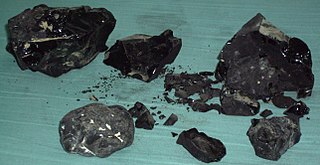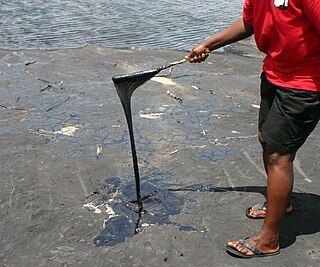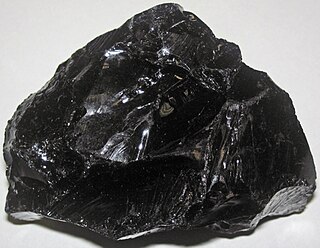Related Research Articles

Bitumen is a sticky, black, highly viscous liquid or semi-solid form of petroleum. In the U.S., it is commonly referred to as asphalt. It may be found in natural deposits or may be a refined product, and is classed as a pitch. Before the 20th century, the term asphaltum was also used. The word is derived from the Ancient Greek ἄσφαλτος ásphaltos. The largest natural deposit of bitumen in the world, estimated to contain 10 million tons, is the Pitch Lake in southwest Trinidad.
Rheology is the study of the flow of matter, primarily in a fluid state, but also as "soft solids" or solids under conditions in which they respond with plastic flow rather than deforming elastically in response to an applied force. Rheology is a branch of physics, and it is the science that deals with the deformation and flow of materials, both solids and liquids.

Tar pits, sometimes referred to as asphalt pits, are large asphalt deposits. They form in the presence of oil, which is created when decayed organic matter is subjected to pressure underground. If this crude oil seeps upward via fractures, conduits, or porous sedimentary rock layers, it may pool up at the surface. The lighter components of the crude oil evaporate into the atmosphere, leaving behind a black, sticky asphalt. Tar pits are often excavated because they contain large fossil collections.

A road surface, or pavement, is the durable surface material laid down on an area intended to sustain vehicular or foot traffic, such as a road or walkway. In the past, gravel road surfaces, macadam, hoggin, cobblestone and granite setts were extensively used, but these have mostly been replaced by asphalt or concrete laid on a compacted base course. Asphalt mixtures have been used in pavement construction since the beginning of the 20th century and are of two types: metalled (hard-surfaced) and unmetalled roads. Metalled roadways are made to sustain vehicular load and so are usually made on frequently used roads. Unmetalled roads, also known as gravel roads, are rough and can sustain less weight. Road surfaces are frequently marked to guide traffic.

Dichloromethane is an organochlorine compound with the formula CH2Cl2. This colorless, volatile liquid with a chloroform-like, sweet odour is widely used as a solvent. Although it is not miscible with water, it is slightly polar, and miscible with many organic solvents.

Asphalt concrete is a composite material commonly used to surface roads, parking lots, airports, and the core of embankment dams. Asphalt mixtures have been used in pavement construction since the beginning of the twentieth century. It consists of mineral aggregate bound together with bitumen, laid in layers, and compacted. The process was refined and enhanced by Belgian-American inventor Edward De Smedt.
The Knudsen number (Kn) is a dimensionless number defined as the ratio of the molecular mean free path length to a representative physical length scale. This length scale could be, for example, the radius of a body in a fluid. The number is named after Danish physicist Martin Knudsen (1871–1949).

A railroad tie, crosstie, railway tie or railway sleeper is a rectangular support for the rails in railroad tracks. Generally laid perpendicular to the rails, ties transfer loads to the track ballast and subgrade, hold the rails upright and keep them spaced to the correct gauge.

Toner is a powder mixture used in laser printers and photocopiers to form the printed text and images on paper, in general through a toner cartridge. Mostly granulated plastic, early mixtures added only carbon powder and iron oxide, however, mixtures have since been developed containing polypropylene, fumed silica, and various minerals for triboelectrification. Toner using plant-derived plastic also exists as an alternative to petroleum plastic. Toner particles are melted by the heat of the fuser, and are thus bonded to the paper.

In polymer chemistry, a copolymer is a polymer derived from more than one species of monomer. The polymerization of monomers into copolymers is called copolymerization. Copolymers obtained from the copolymerization of two monomer species are sometimes called bipolymers. Those obtained from three and four monomers are called terpolymers and quaterpolymers, respectively. Copolymers can be characterized by a variety of techniques such as NMR spectroscopy and size-exclusion chromatography to determine the molecular size, weight, properties, and composition of the material.

Asphaltite is a naturally occurring soluble solid hydrocarbon, a form of asphalt with a relatively high melting temperature. Its large-scale production occurs in the Uintah Basin of Utah and Colorado, United States. Although the substance has been historically mined in the Uintah Basin, resources are being discovered and mined more recently in other countries such as Colombia and Iran. Gilsonite is mined in underground shafts and resembles shiny black obsidian. Discovered in the 1860s, it was first marketed as a lacquer, electrical insulator, and waterproofing compound approximately 25 years later by Samuel H. Gilson.

A flat roof is a roof which is almost level in contrast to the many types of sloped roofs. The slope of a roof is properly known as its pitch and flat roofs have up to approximately 10°. Flat roofs are an ancient form mostly used in arid climates and allow the roof space to be used as a living space or a living roof. Flat roofs, or "low-slope" roofs, are also commonly found on commercial buildings throughout the world. The National Roofing Contractors Association defines a low-slope roof as having a slope of 3 in 12 (1:4) or less.

Material efficiency is a description or metric (Mp) (the ratio of material used to the supplied material) which refers to decreasing the amount of a particular material needed to produce a specific product. Making a usable item out of thinner stock than a prior version increases the material efficiency of the manufacturing process. Material efficiency goes hand in hand with Green building and Energy conservation, as well as other ways of incorporating Renewable resources in the building process from start to finish.

Potassium peroxymonosulfate is widely used as an oxidizing agent. It is the potassium salt of peroxymonosulfuric acid. Usually potassium peroxymonosulfate refers to the triple salt known as oxone.

An asphalt shingle is a type of wall or roof shingle that uses asphalt for waterproofing. It is one of the most widely used roofing covers in North America because it has a relatively inexpensive up-front cost and is fairly simple to install.

Bituminous waterproofing systems are designed to protect residential and commercial buildings. Bitumen is a mixed substance made up of organic liquids that are highly sticky, viscous, and waterproof. These systems are sometimes used to construct roofs, in the form of roofing felt or roll roofing products.
Rubber toughening is a process in which rubber nanoparticles are interspersed within a polymer matrix to increase the mechanical robustness, or toughness, of the material. By "toughening" a polymer it is meant that the ability of the polymeric substance to absorb energy and plastically deform without fracture is increased. Considering the significant advantages in mechanical properties that rubber toughening offers, most major thermoplastics are available in rubber-toughened versions; for many engineering applications, material toughness is a deciding factor in final material selection.
Sulfur concrete, sometimes named thioconcrete or sulfurcrete, is a composite construction material, composed mainly of sulfur and aggregate. Cement and water, important compounds in normal concrete, are not part of sulfur concrete. The concrete is heated above the melting point of elemental sulfur at ca. 140 °C (284 °F) in a ratio of between 12% and 25% sulfur, the rest being aggregate.
Clark Landis is an American chemist, whose research focuses on organic and inorganic chemistry. He is currently a Professor of Chemistry at the University of Wisconsin–Madison. He was awarded the ACS Award in Organometallic Chemistry in 2010, and is a fellow of the American Chemical Society and the American Association for the Advancement of Science.
The Eazy PC is an all-in-one IBM PC compatible computer manufactured by Zenith Data Systems (ZDS) starting in 1987. This small-form-factor XT-compatible system has some unique features, such as using a non-Intel CPU. The Eazy PC was designed to be a simple, cost-effective computer for the home. This was a departure for ZDS, who had historically avoided the retail consumer market to focus on customers such as businesses, universities, and government agencies.
References
- ↑ An, Yanqing; Zianzhi, Shao (September 2014). "Effect of Aging on Rheological Property of Cariphalte Modified Asphalt". Applied Mechanics and Materials. 638–640: 1149–1152. doi:10.4028/www.scientific.net/AMM.638-640.1149. ISSN 1660-9336. S2CID 110387911. Archived from the original on 2021-03-01. Retrieved 2021-03-01– via ProQuest.
- ↑ Hua, Tan (September 2014). "Study of Rheological Properties of Cariphalte Modified Asphalt". Applied Mechanics and Materials. 638–640: 1185–1189. doi:10.4028/www.scientific.net/AMM.638-640.1185. ISSN 1660-9336. Archived from the original on 2021-03-01. Retrieved 2021-03-01– via ProQuest.
- ↑ "Tackling Reflective Cracks". Civil Engineering. Morgan Grampian: 30. May 1988. ISSN 0305-6473 . Retrieved 2021-03-01– via Internet Archive.
- 1 2 Hunter, Robert N. (1997) [1994]. Bituminous Mixtures in Road Construction. London: Thomas Telford. p. 36. ISBN 0-7277-1683-2 . Retrieved 2021-03-01– via Google Books.